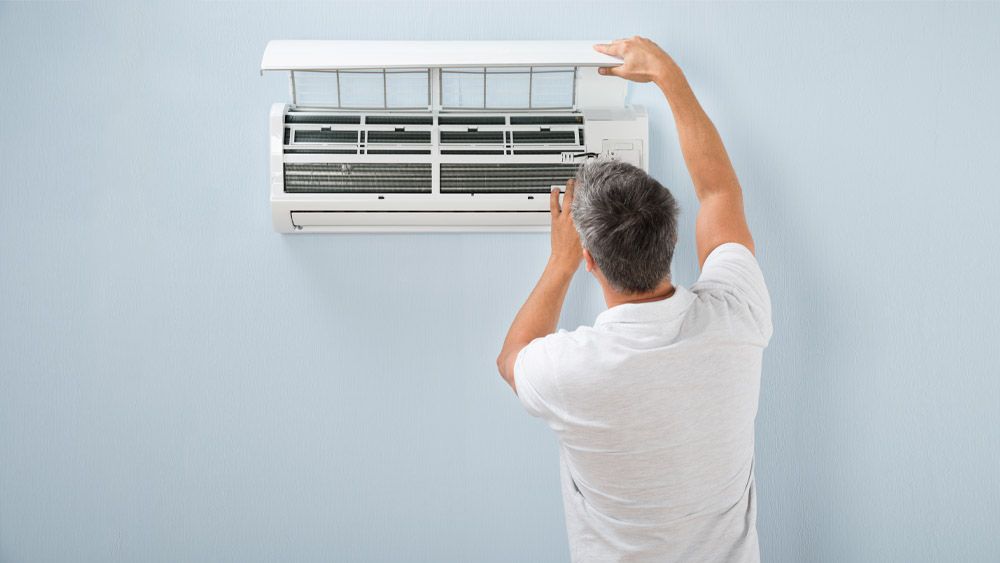
Key Takeaways
- Dirty AC coils restrict heat transfer, forcing your system to work harder.
- It is essential to regularly clean AC coils to improve efficiency.
- You can easily clean the coils using a brush, compressed air, or commercial cleaners.
AC coils play a crucial role in your cooling system by transferring heat from indoors to outdoors, maintaining a comfortable home environment. When the coils are clogged, your AC consumes more energy, making your bills higher and causing regular repairs. Regularly cleaning your coils makes your AC more efficient, saves you money on energy, and increases the unit’s longevity.
The best part about cleaning AC coils is that you don’t have to rely on HVAC technicians. You can complete this cleaning task in less than an hour with a few supplies at home. To help you in your DIY AC coil cleaning project, here’s a detailed guide on how to do it using various methods.
Types of Air Conditioner Coils
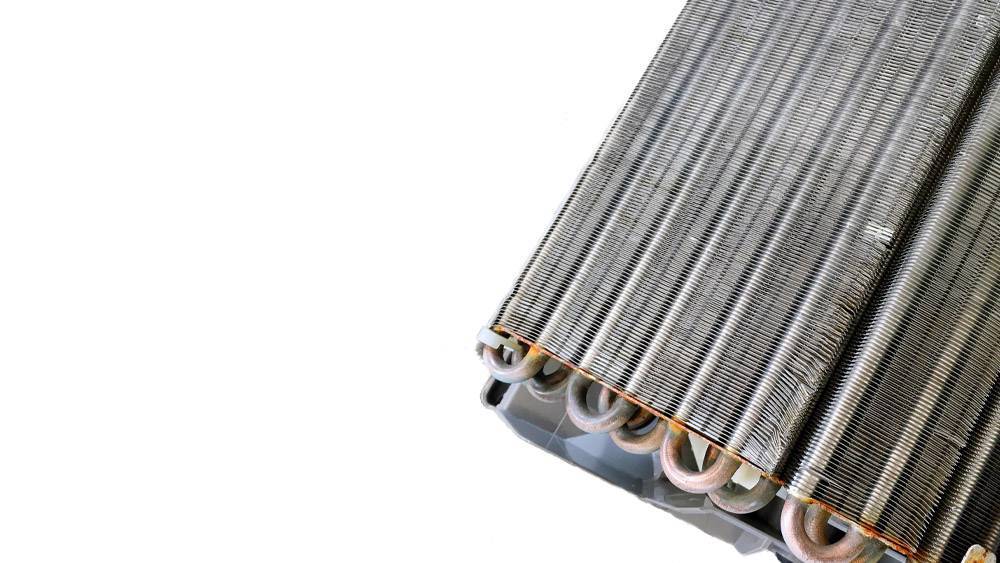
Two types of coils are found in an air conditioner: the evaporator coil and the condenser coil. They work in conjunction with each other during the heat transfer process. Any issue with either one could cause your HVAC system to break down and stop functioning.
1. Evaporator Coils
The evaporator coils are U-shaped tubes made of copper, aluminum, or steel located in the indoor air handler. They are placed behind thin metal strips called fins and carry the cool refrigerant inside them.
When warm air from inside your home blows over the evaporator coils, the refrigerant inside absorbs the heat and the resultant cool air circulates inside your home.
Regular cleaning of the evaporator coil is essential to maintain its efficiency. Dirt buildup can reduce airflow and hinder the coil’s ability to absorb heat.
2. Condenser Coils
You can see the condenser coils outside in the AC cabinet; they are narrow metal tubes curved around the sides or back of the appliance. The coils allow the inside heat to flow from your house outside.
How Do AC Coils Get Dirty?
The moisture, dust, and other pollutants accumulate over time on the surface of your coils. If you haven’t cleaned your AC filters in a while, excess dirt can start depositing on the evaporator coils and can pose severe damage. Your AC would consume more energy, resulting in higher bills. Changing your air filters can help you improve your energy efficiency by 5% to 15%.
Outdoor condenser coils can become dirty if the outdoor environment is not clean or if you have shrubs planted around to conceal your outdoor unit. Falling leaves can enter your condenser and clog the coils.
How to Clean AC Coils? A Quick Guide
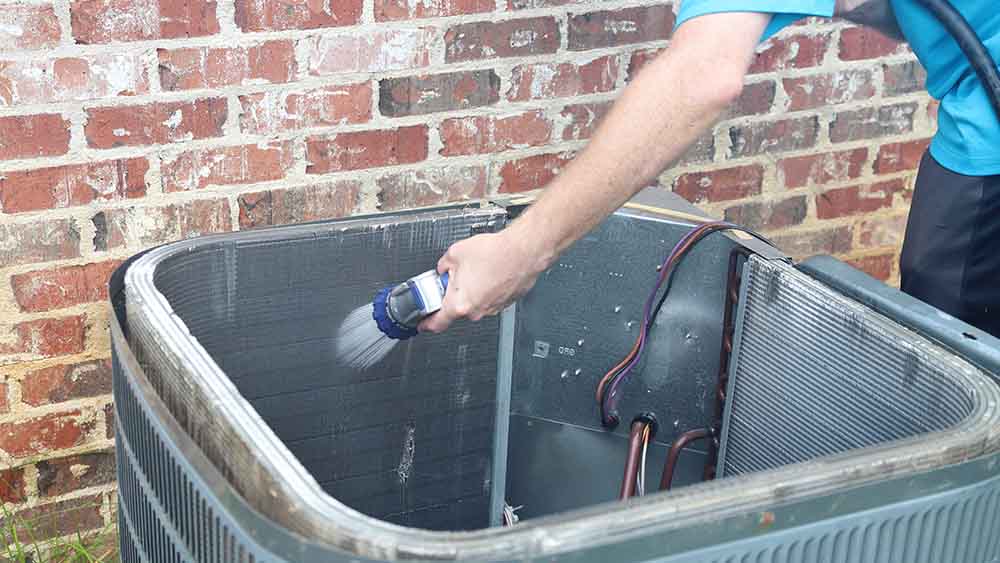
AC coil cleaning may seem daunting, but it’s actually fairly quick and easy. First, turn off your AC unit and disconnect it from the power source. Next, remove the coil access panel so that you can access the coils. Use a brush or AC oil cleaner to remove any dirt, dust, or debris. Be sure to get into all the nooks and crannies. Once the coils are clean, reattach the access panel and turn on your AC unit.
For a detailed AC coil cleaning guide, read on!
How to Locate Your AC Coils?
Here’s how to locate the evaporator and condenser coils.
Gaining Access to Evaporator Coils
- To reach the coils in your indoor unit, you have to remove the access panel.
- Check your AC’s manual to find out where the access panel is located.
- Remove the tape that seals the panel.
- Then remove any screws or fasteners attached to the access panel.
- Remove the panel cover to gain entry to the coils.
- You will see a V-shaped frame of two panels of coils lined with aluminum fins.
Gaining Access to Condenser Coils
- Turn off your unit and remove the condenser cover.
- Inside the unit, you will see a cage.
- Remove the screws at the bottom of the cage
- After removing the cage, you will see the fins along with the AC coils.
Note: If you are still having trouble finding the coils, refer to your AC’s user manual. The diagrams in the manual can help find the exact location.
1. Brush Cleaning (Ideal for Routine Maintenance)
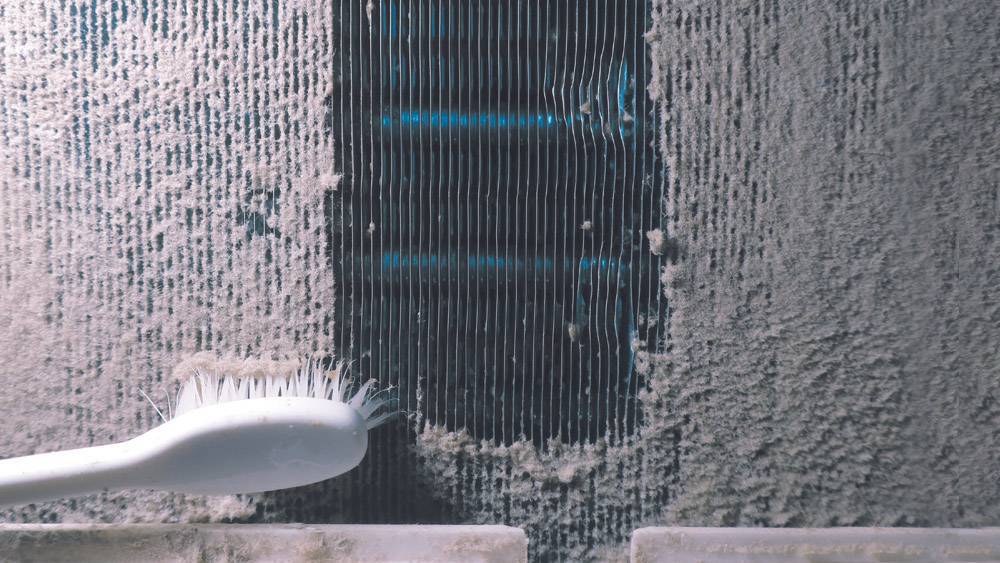
If there’s light dust and you’re just doing routine maintenance, this is the easiest and safest method.
Tools Required:
- Coil comb
- Fin comb
- Gloves
- Soft cleaning brush
How to Clean:
- Examine the external surface of the coils for any traces of leaves, layers of dust, or spider webs.
- Pick up dust and dirt using the soft brush by sweeping along the fins, rather than against them.
- Use a coil comb to clean the area between the coil fins. Do not force the comb where it does not pass through easily; you can easily tear the thin fins.
- Never apply much force, since the aluminum fins can be easily bent.
- If you notice any bent fins, gently straighten them using a fin comb. Run it parallel to the fin line for straightening.
Note: Avoid using brushes with hard bristles, as your AC coils have delicate fins that can be damaged.
2. Compressed Air Cleaning (For Outdoor Coils)
Compressed air can be used if you have only a little dust to clean on the condenser coils. You should employ this method to clean the condenser coils.
Materials Required:
- An air compressor or can.
- Make sure to have safety goggles and a face mask on.
How to Clean
- Direct compressed air to flow in the direction opposite to the airflow.
- If one side needs more cleaning, place the nozzle close to that side and direct the air.
- Maintain a constant flow; it will help remove the dust smoothly and prevent any damage to the coils.
- If high pressure is required, use a 90-degree angle or blow straight to the fins so that they don’t bend.
- After you are finished, place the cover back securely and clean the area around your outdoor unit.
Pro tip: Use a straw nozzle attachment to reach tight areas between the fins.
3. Commercial Coil Cleaners (Best for Grease & Heavy Dirt)
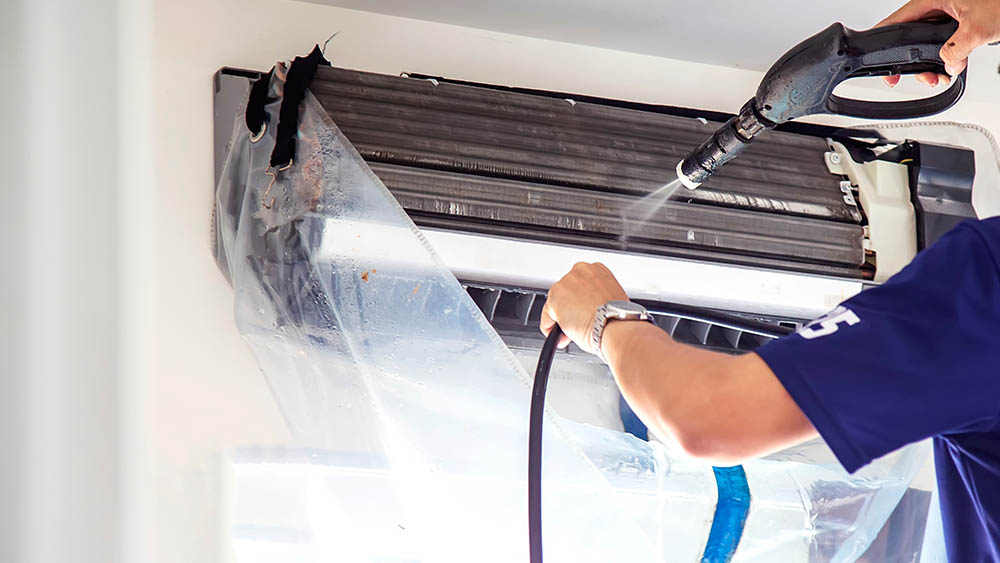
There are many chemical cleaners on the market formulated for people who want to clean their AC coils themselves. Foaming cleansers are widely available as they can easily loosen the dirt and debris on the coils. For copper coils, avoid using acidic cleaners.
Materials Required
- Coil cleaner
- Garden hose (for outdoor coils)
How to Clean
- Before using the detergent, read all the instructions provided.
- Give the coil cleaner a good shake and then coat the coils evenly with the spray. Let it sit for 5-10 minutes.
- It will allow for the buildup in your hair to be released and separated. Use a mild stream of water to clean the outdoor coils.
- If the cleaner label instructs to rinse off foam, use a garden hose on low-pressure settings. For indoor coils, you can use a rinse-free cleanser.
- After rinsing the coils, don’t turn on your air conditioner immediately. Let the unit dry for 30 to 60 minutes.
Tip: Always follow the manufacturer’s directions on the label.
4. Homemade Cleaning Solutions (Budget-Friendly & Non-Toxic)
If you don’t want to use commercial cleaners, you can opt for a simple AC coil cleaner that you can make at home.
Materials Required
- Mild detergent
- Clean water
- Spray bottle
- Soft cloth or soft brush
- Garden hose
How to Clean
- Mix detergent and warm water, and put it in a spray bottle.
- Spray evenly on the coils and let the cleaner sit for a few minutes.
- Then wipe all the grime with a piece of cloth. In case of condenser coils, you can rinse with water using a garden hose.
- Wait for 30-60 minutes and let the unit dry before turning it on.
Warning: Never use pressure washing indoors, and avoid directing steam at electrical components.
Why It’s Beneficial to Clean AC Coils
Cleaning coils helps improve your system’s efficiency, minimize wear and tear, and save on energy bills.
-
Better Cooling Performance
As dirt accumulates on coils, their ability to absorb and release heat decreases dramatically. This results in poor cooling performance, and your AC struggles to maintain a consistent temperature.
Cleaning the coils restores their ability to function properly, ensuring optimal cooling.
-
Lower Energy Bills
If your coils are filled with dirt, your AC has to try harder to cool your home. Because it uses more power, it stays on for a longer time, which leads to high bills. If you maintain your coil regularly, your AC will operate more efficiently, consuming less energy.
-
Less Wear & Tear
When coils are dirty, your AC unit has to work harder to maintain your preferred temperature. This puts extra strain on the condenser fan, which runs constantly to push out hot air, leading to faster wear and tear.
A routine cleaning of the air conditioner’s coil lowers the load on your system and reduces the risk of issues that could affect its overall performance and lifespan.
-
Improved Air Quality & Comfort
Dirty coils can restrict airflow and cause uneven cooling, leading to an uncomfortable environment and poor humidity control. Clean coils ensure consistent airflow and effective moisture removal, enhancing comfort while also preventing mold growth.
When to Replace Air Conditioner Coils
Coil replacement is expensive, but running your AC with damaged coils may lead to even more serious issues. You may even need to go for a full system replacement. Replacing or repairing AC coils typically costs between $500 and $2,500, depending on the size of the unit and your location.
Signs Your Evaporator Coil Needs Replacing
- Water leakage from your AC.
- Your AC is blowing warm air.
- You are hearing odd AC noises.
Signs Your Condenser Coil Needs Replacing
- The unit takes longer to achieve your preferred temperature.
- Ice formation on condenser coils.
When to Call a Professional
- When the fins on the coil are deeply bent, re-straightening them with a fin comb may not be effective. Improper handling can result in more damage.
- When it has been a long time since you have cleaned the coils and they have become quite dirty, it’s best to call the pros. They have special products and tools to properly clean the coils.
- If you’re unsure about cleaning the coils on your own, you can have a professional take care of it during your annual HVAC maintenance visit.
Frequently Asked Questions
Will Dirty AC Coils Affect Cooling Performance?
Yes, dirty AC coils can significantly impact cooling efficiency. When coils are covered in dust or grime, your system has to work much harder to cool your space, resulting in higher energy bills and reduced comfort. Over time, this strain can even cause wear and tear to your system.
How Often Should You Clean Your AC Coils?
You should clean the coils at least once a year. If you live in a dusty area, have pets, or run your AC frequently, you might need to clean them more often. In case of heat pumps that operate all year, you can do the cleaning once in spring and once in fall.
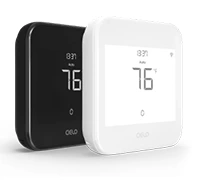
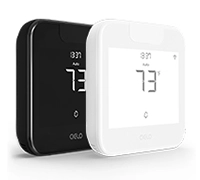
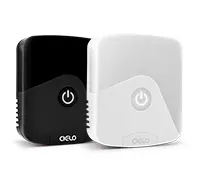


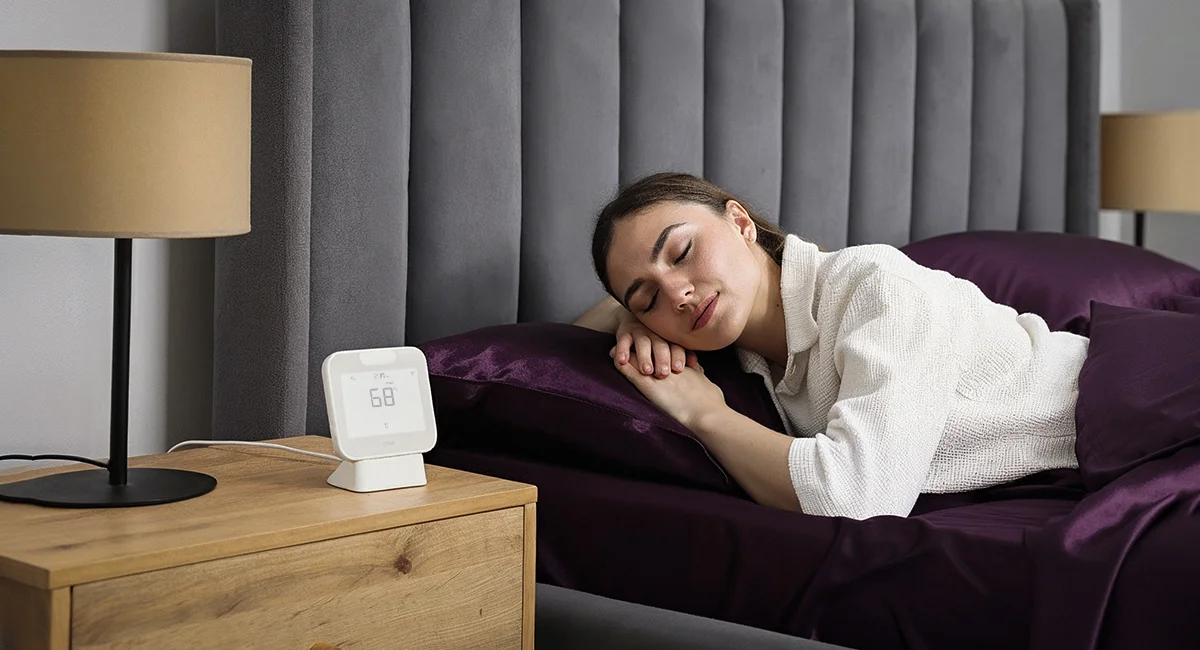


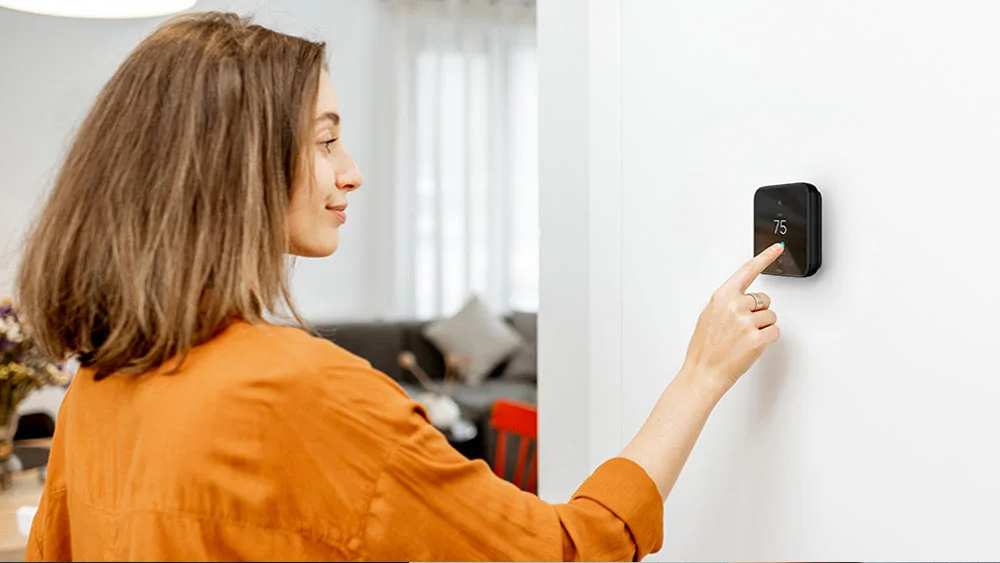
1 Comment. Leave new
Thank you for guiding me about Coil Cleaning